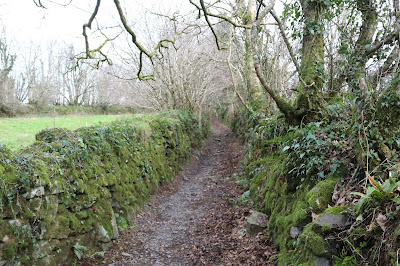 |
| Our route (in blue) for the day, starting and ending at SX52203 80248. |
 |
| Just a piece of the mechanism controlling the rise and fall of the water in the leat. It looked rather lonely and unloved. |
 |
| I'm always intrigued by lichen: all aspects of it, really. Its shape, its habitat, its colour. |
 |
| Looking closer than it really is, Kit Hill can be seen to the west with its characteristic column on the top. It was about 15 miles away from this spot. We live just the other side of the lump. |
| Maidenhair spleenwort, Asplenium trichomanes subspecies trichomanes, the subspecies is named according to the rounded, not oblong, pinnae. Other wise it would be plain old Asplenium trichomanes. It's a lime-loving plant and is found in the mortar of old walls, as this one was. |
For the Lobaria, Usnea, Witches Hair, Map Lichen, Beard Lichen, Ground Lichen, Shield Lichen.
Back then, what did I know?
The names of subway lines, busses.
How long it took to walk 20 blocks.
Uptown and downtown.
Not north, not south, not you.
When I saw you, later, seaweed reefed in the air,
you were grey-green, incomprehensible, old.
What you clung to, hung from: old.
Trees looking half-dead, stones.
Marriage of fungi and algae,
chemists of air,
changers of nitrogen-unusable into nitrogen-usable.
Like those nameless ones
who kept painting, shaping, engraving,
unseen, unread, unremembered.
Not caring if they were no good, if they were past it.
Rock wools, water fans, earth scale, mouse ears, dust,
ash-of-the-woods.
Transformers unvalued, uncounted.
Cell by cell, word by word, making a world they could live in
The names of subway lines, busses.
How long it took to walk 20 blocks.
Uptown and downtown.
Not north, not south, not you.
When I saw you, later, seaweed reefed in the air,
you were grey-green, incomprehensible, old.
What you clung to, hung from: old.
Trees looking half-dead, stones.
Marriage of fungi and algae,
chemists of air,
changers of nitrogen-unusable into nitrogen-usable.
Like those nameless ones
who kept painting, shaping, engraving,
unseen, unread, unremembered.
Not caring if they were no good, if they were past it.
Rock wools, water fans, earth scale, mouse ears, dust,
ash-of-the-woods.
Transformers unvalued, uncounted.
Cell by cell, word by word, making a world they could live in







1 comment:
I really enjoyed your blog on the walk from Zoar Chapel. I live in Scotland, however I am descended from the Friend family (many of whom are interred at Zoar). When I visited a couple of years ago I was a little concerned about the holiday let permission as my grandfathers grave was unmarked and I didn't relish his last resting place being turned into a picnic area or garden so I returned with a granite plaque to mark the grave of Hedley James Friend.
Many thanks for your beautiful photos of this gorgeous area where I always feel at home (and close to my late mum) when I visit.
Post a Comment